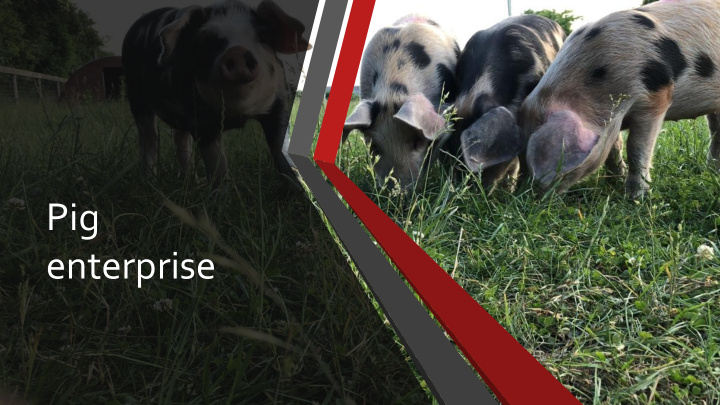



Pig enterprise
Project aims My aims were: • to buy “in store” weaners and raise them for slaughter at 6 months • learn enterprise and animal welfare skills • sell the meat for a profit • raise money for a scout event
Arriving • We went to collect the pigs on the 1 st May when they were 8 weeks old • I bought from a reputable breeder in Suffolk who I have known for some time • The pigs arrived into a full patch of green grass and a sty that was full of straw • As soon as they arrived they began rooting and slowly turning their patch into mud covered land - which they love!
Growing • On arrival, the pigs weighed just 20kg, and were only eating 2.5 lb of feed each per day • After 6 months they weighed 98kg and were eating 4lb of feed each per day The piglets on arrival The pigs after 6 months
Pasture • The pigs were kept in their area by strands of electric fence wire, powered by a car battery and energiser • This proved a problem as this summer the ground was very dry and therefore the fences earth was not very good • The pigs did have a few excited moments when the fence was on low power and they managed to escape into the rest of the field • This proved interesting but fun when they had to be rounded up and put back in their area
Food and water • I set up an automatic water feeder in the pigs area which was supplied by a tank • This meant that the pigs could get water when they wanted and the tank was filled up once a week • They had food twice a day. The amount increased as they got older - from 2.5lb to 4 lb per pig per day
Leaving us • The pigs went to the abattoir on the 22 nd of November, and returned (in boxes) on the 26 th of November • Each box contained half a pig – and all cuts were bagged and labelled • All meat was sold at £3.50/lb • Kill and butchering cost £50 per pig
Pop-up-shop • I then hosted a pop-up-shop in our kitchen on Friday 26 th of October from 4- 9 pm • I had already taken orders for 2 whole pigs and people also turned up on the night • I advertised around the village and to family and friends • We also made sausages at home for ourselves
Pig pleasure • Pigs love attention, to be scratched and to play, but they also love to chew wellies and shoes • My pigs were free range and had no interference. As a result they had none of the problems associated with intensive farming. Please see the following extract which outlines how intensive farming methods impact on pig welfare
Extract from: AHDB (2017) Real Welfare. Baseline report: 2013-2016. Measuring welfare outcomes in pigs Cardiovascular problems and leg problems are widespread in pigs as a result of breeding for faster growth. Pigs are also bred for increased litter size, which often leads to lower piglet birth weight and higher piglet mortality. Competition for access to teats is increased in larger litter leading to a greater risk of injuries to the piglets and to the sow’s teats. Piglets are often subjected to tooth clipping to reduce the risk of injuries which causes acute pain and distress. Most piglets in the EU are also routinely tail-docked in an attempt to address abnormal behaviour (tail biting) caused by lack of appropriate substrate to explore and sufficient space. Most breeding sows in the EU are confined in crates during farrowing and lactation and many also spend up to four weeks confined in a stall during early gestation, causing suffering. Since 2003, routine tail docking and tooth clipping are prohibited for pigs in the EU, but despite this, these procedures continue to be performed routinely in most EU countries including the UK, for example 70% of British pigs are still tail docked.
Eating less and better A new report by the Eating Better coalition of more than 50 civil society groups, shows consumers how the choices of meat and dairy products they buy have an impact on global problems, such as climate change, antibiotic use, hunger and malnutrition, and animal welfare. They hope that advocating a “less and better” approach will help reduce the environmental impact meat production, as well as proving healthier.
Guidelines The campaign have drawn up 8 principles for consumers. 1. Choose better for the climate 2. Choose better for animals 3. Choose better for nature 4. Choose better for feeding the world fairly 5. Choose better for health 6. Choose better for responsible antibiotic use 7. Choose better for cutting waste 8. Choose better for livelihoods By choosing to eat my pigs my consumers were following many of these 8 principles.
Reflection... What went well? What could be improved? • The pigs were very healthy and happy • I could have improved the feeding program - • No vet bills were incurred so that the animals reached peak weight in the least amount of time • They each gained roughly 80kg • I could have improved the sales- by closer • I achieved my aims and I really enjoyed doing it contact with my customers and more notice • I developed skills in customer care, marketing about the shop and animal husbandry
Recommend
More recommend